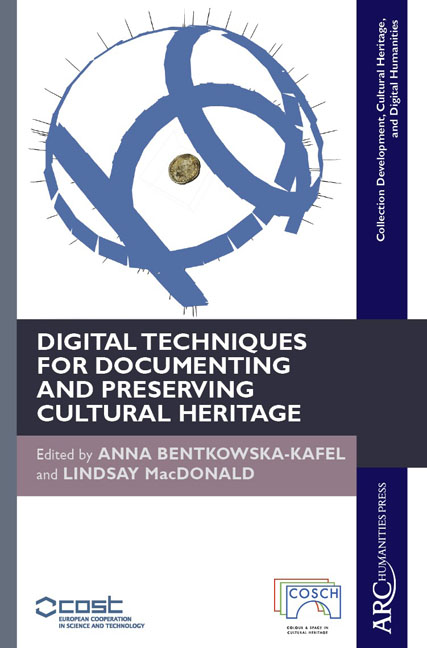Focus Stacking
Published online by Cambridge University Press: 26 January 2021
Summary
The COSCH Case Study that has employed this technology: Roman coins (fig. 15.1)
Definition
Focus stacking is a technique which extends the depth of focus of an image by combining different images with low depth of field. It is mostly used in close-up and macrophotography since in those cases the lens, even at high f-stop, is not able to render everything in focus. This method, although not used often in cultural heritage, is useful to document objects and to illustrate details. It can also be used in combination with Structure from Motion (SfM) in order to create accurate 3D models of small artefacts.
Description
Focus stacking allows the extension of the focus range of a single view, using the lens at its optimal f-number (typically in the range f/8 to f/11). If the lens is stopped down more than its optimal f-number, the depth of field is larger, but the image is softer (less sharp) due to diffraction. The starting point for focus stacking is a series of images, with different regions in focus. Although none of the images has the object of interest entirely in focus, collectively they contain all of the data required to generate an image that has all parts in focus. The in-focus regions of each image may be selected manually or detected automatically, for example, via edge detection or a sharpness metric or Fourier analysis. The in-focus regions are then blended together, pixel by pixel, to generate the final image.
This process is also known as z-stacking or focal plane merging.
Significant Applications
Example 1: Rock Art Studies
Plisson and Zotkina (2015) tested the potential of focus stacking for 3D recording of submillimetric details of prehistoric petroglyphs and paintings. They tested their technique at open air sites in France, Portugal, and Russia. The study shows that focus stacking and photogrammetry are complementary.
Plisson, H., Zotkina, L. V. 2015. “From 2D to 3D at Macro-and Microscopic Scale in Rock Art Studies.” Digital Applications in Archaeology and Cultural Heritage 2.2: 102‒19.
Example 2: Venus of Frasassi
The Venus of Frasassi is an 87 mm high Palaeolithic sculpture carved in a stalactite. It was found in a cave in the Frasassi Gorge (hence the name) in Central Italy and is housed in the National Archaeological Museum of the Marche in Ancona. The figurine was recorded using focus stacking pictures combined with photogrammetry to achieve a 3D model.
- Type
- Chapter
- Information
- Publisher: Amsterdam University PressPrint publication year: 2018



